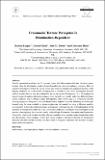Files in this item
Crossmodal texture perception is illumination-dependent
Item metadata
| dc.contributor.author | Kangur, Karina | |
| dc.contributor.author | Giesel, Martin | |
| dc.contributor.author | Harris, Julie | |
| dc.contributor.author | Hesse, Constanze | |
| dc.date.accessioned | 2023-01-09T12:30:08Z | |
| dc.date.available | 2023-01-09T12:30:08Z | |
| dc.date.issued | 2023-01-01 | |
| dc.identifier | 282489731 | |
| dc.identifier | 3c501618-7def-4313-b52a-5701468175cf | |
| dc.identifier | 85146004483 | |
| dc.identifier | 000920262100004 | |
| dc.identifier.citation | Kangur , K , Giesel , M , Harris , J & Hesse , C 2023 , ' Crossmodal texture perception is illumination-dependent ' , Multisensory Research , vol. 36 , no. 1 , pp. 75-91 . https://doi.org/10.1163/22134808-bja10089 | en |
| dc.identifier.issn | 2213-4794 | |
| dc.identifier.other | ORCID: /0000-0002-3497-4503/work/126554395 | |
| dc.identifier.uri | https://hdl.handle.net/10023/26716 | |
| dc.description | Funding: This work was supported by the Leverhulme Trust (grant number RPG-2017-232) awarded to Constanze Hesse and Julie Harris and the Biotechnology and Biological Sciences Research Council (BBSRC) (grant number BB/M010996/1), EastBIO Doctoral Training Partnership awarded to Karina Kangur. | en |
| dc.description.abstract | Visually perceived roughness of 3D textures varies with illumination direction. Surfaces appear rougher when the illumination angle is lowered resulting in a lack of roughness constancy. Here we aimed to investigate whether the visual system also relies on illumination-dependent features when judging roughness in a crossmodal matching task or whether it can access illumination-invariant surface features that can also be evaluated by the tactile system. Participants (N = 32) explored an abrasive paper of medium physical roughness either tactually, or visually under two different illumination conditions (top vs oblique angle). Subsequently, they had to judge if a comparison stimulus (varying in physical roughness) matched the previously explored standard. Matching was either performed using the same modality as during exploration (intramodal) or using a different modality (crossmodal). In the intramodal conditions, participants performed equally well independent of the modality or illumination employed. In the crossmodal conditions, participants selected rougher tactile matches after exploring the standard visually under oblique illumination than under top illumination. Conversely, after tactile exploration, they selected smoother visual matches under oblique than under top illumination. These findings confirm that visual roughness perception depends on illumination direction and show, for the first time, that this failure of roughness constancy also transfers to judgements made crossmodally. | |
| dc.format.extent | 17 | |
| dc.format.extent | 699533 | |
| dc.language.iso | eng | |
| dc.relation.ispartof | Multisensory Research | en |
| dc.subject | Multisensory | en |
| dc.subject | Visual perception | en |
| dc.subject | Haptics | en |
| dc.subject | Surface roughness | en |
| dc.subject | Constancy | en |
| dc.subject | BF Psychology | en |
| dc.subject | RC0321 Neuroscience. Biological psychiatry. Neuropsychiatry | en |
| dc.subject | NDAS | en |
| dc.subject | MCC | en |
| dc.subject.lcc | BF | en |
| dc.subject.lcc | RC0321 | en |
| dc.title | Crossmodal texture perception is illumination-dependent | en |
| dc.type | Journal article | en |
| dc.contributor.institution | University of St Andrews. School of Psychology and Neuroscience | en |
| dc.contributor.institution | University of St Andrews. Institute of Behavioural and Neural Sciences | en |
| dc.identifier.doi | https://doi.org/10.1163/22134808-bja10089 | |
| dc.description.status | Peer reviewed | en |
| dc.identifier.url | https://osf.io/s34bz/ | en |
This item appears in the following Collection(s)
Items in the St Andrews Research Repository are protected by copyright, with all rights reserved, unless otherwise indicated.

